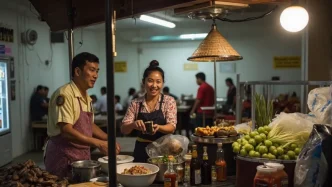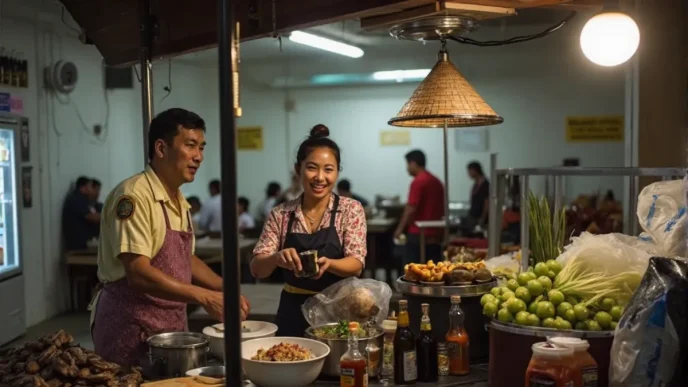In the heart of Bangkok’s bustling Chatuchak District, a devastating tragedy has unfolded following the collapse of a 30-storey building under construction for the State Audit Office (SAO). The incident, triggered by a powerful 8.2-magnitude earthquake near Mandalay, Myanmar, on March 28, 2025, has claimed dozens of lives and left many families grappling with loss and uncertainty. As rescue efforts continue, outrage is growing over the meager compensation offered by the construction company, prompting legal action from victims’ relatives with support from the Lawyers Council of Thailand.
A Catastrophic Collapse
The under-construction high-rise came crashing down in the early hours of March 28, trapping over 100 workers inside. According to the Bangkok Metropolitan Administration (BMA), the disaster has resulted in 62 confirmed deaths, nine injuries, and 32 individuals still unaccounted for. The scale of the loss has shaken the city, with forensic teams working tirelessly to identify remains—over 120 body parts have been recovered so far—while the official death toll stands at 62 pending further confirmation.
Rescue operations have been grueling, with teams navigating through layers of debris to reach trapped individuals. Deputy Governor of Bangkok Tavida Kamolvej reported that the debris pile has been reduced to 3.5 meters in height. “In two days, we expect to reach ground level and begin operations near the elevator shaft in Zone C, where we believe multiple bodies are located” she said. Authorities are proceeding cautiously, anticipating the recovery of more remains in the coming days.
“Today, the teams aim to remove around 330 truckloads of debris to clear the front area” Tavida added. “Recovery from the basement will be more challenging and could take another week. We expect to find more construction workers there.” The painstaking process underscores the magnitude of the disaster and the difficulties in accessing the most affected areas of the site.
Outrage Over Compensation
Amid the ongoing recovery efforts, anger has surfaced over the response from the construction company responsible for the project. The company has offered a compensation of just 50,000 Thai Baht (US$1,400) per victim, a sum widely criticized as inadequate given the scale of the tragedy. For many families, the amount fails to address the profound loss of life and the financial burden left in its wake.
Wichian Chubtaisong, President of the Lawyers Council of Thailand, has condemned the offer and mobilized a team of volunteer lawyers to support the affected families. “Despite the scale of the tragedy, the company has only offered 50,000 baht per victim” he said on Saturday. “Fifteen families have filed complaints with the council to pursue civil lawsuits for damages based on negligence.”
The legal push comes as a response to what many see as a failure of accountability. While the earthquake was a natural disaster, questions remain about whether the building’s design and construction adhered to safety standards capable of withstanding such seismic activity. The Lawyers Council aims to hold the company accountable, seeking justice for those who lost loved ones or sustained life-altering injuries in the collapse.
Rescue and Recovery Challenges
The rescue operation has been a race against time, with teams working around the clock to clear rubble and search for survivors or remains. The focus on Zone C and the elevator shaft highlights the complexity of the task, as these areas are believed to hold critical clues to the fate of the 32 missing individuals. Meanwhile, the recovery of body parts from the basement poses additional logistical and emotional challenges for both rescuers and families awaiting news.
The Chatuchak District Office has issued 44 death certificates to date, while forensic analysis has confirmed the identities of 62 individuals. The discrepancy reflects the difficulty in piecing together the full toll of the disaster, as authorities continue to process remains and update records. For the families of the missing, the uncertainty adds another layer of grief to an already unbearable situation.
Broader Implications for Construction Safety
The collapse has sparked a wider debate about construction safety standards in Thailand, particularly in a region prone to seismic activity due to its proximity to fault lines in neighboring Myanmar. While the 8.2-magnitude earthquake was an extraordinary event, critics argue that high-rise buildings in urban centers like Bangkok must be engineered to endure such forces. If confirmed, any lapses in structural integrity or regulatory oversight could have far-reaching consequences for the construction industry.
Urban planners and engineers are now under scrutiny as the public demands answers. Was the SAO building constructed with adequate safeguards? Were building codes strictly enforced by the Bangkok Metropolitan Administration? These questions are likely to shape investigations in the coming months, potentially leading to stricter regulations or penalties for non-compliance. For now, no official findings have been released regarding the cause of the collapse beyond the earthquake’s impact, and speculation remains just that—unverified.
Community and Government Response
The Bangkok community has rallied in the wake of the disaster, with local organizations and volunteers offering support to affected families. Vigils have been held in Chatuchak District to honor the victims, while social media platforms have amplified calls for greater corporate responsibility and government intervention. Many residents are urging the authorities to ensure that compensation reflects the true cost of the tragedy, both in human and economic terms.
The BMA, for its part, has pledged to oversee the rescue and recovery process transparently, providing regular updates on progress. Deputy Governor Tavida’s statements reflect a commitment to thoroughness, even as the timeline for full recovery stretches into the coming weeks. Additionally, there are indications that the government may step in to provide supplementary aid to victims’ families, though no concrete plans have been announced as of yet.
Economic and Social Fallout
The economic ripple effects of the collapse are beginning to emerge, particularly for the families of the workers—many of whom were likely the primary breadwinners for their households. The loss of income, coupled with medical or funeral expenses, places an immense burden on those left behind. The 50,000 Baht (US$1,400) offered by the construction company barely scratches the surface of these costs, fueling the push for legal recourse.
Beyond individual households, the incident raises concerns about public trust in infrastructure projects. The State Audit Office building was meant to symbolize governmental oversight and accountability, yet its collapse has instead become a stark reminder of vulnerability. Rebuilding confidence in such projects will require not only structural reforms but also a cultural shift toward prioritizing safety over expediency or cost-cutting.
Looking Ahead
As rescue teams inch closer to the deepest layers of debris in Chatuchak, the families of the victims and the missing hold onto hope for closure, if not survival. The legal battle spearheaded by the Lawyers Council of Thailand signals a broader fight for justice—one that may set a precedent for how corporate entities are held accountable in the aftermath of disasters. Meanwhile, the city of Bangkok watches closely, aware that the outcome of this tragedy could redefine safety standards for years to come.
For now, the focus remains on the painstaking work at the collapse site. Each truckload of debris removed brings authorities closer to answers, even as it uncovers more heartbreak. As the recovery unfolds, one question lingers in the minds of many: how can such a loss be prevented in the future?














